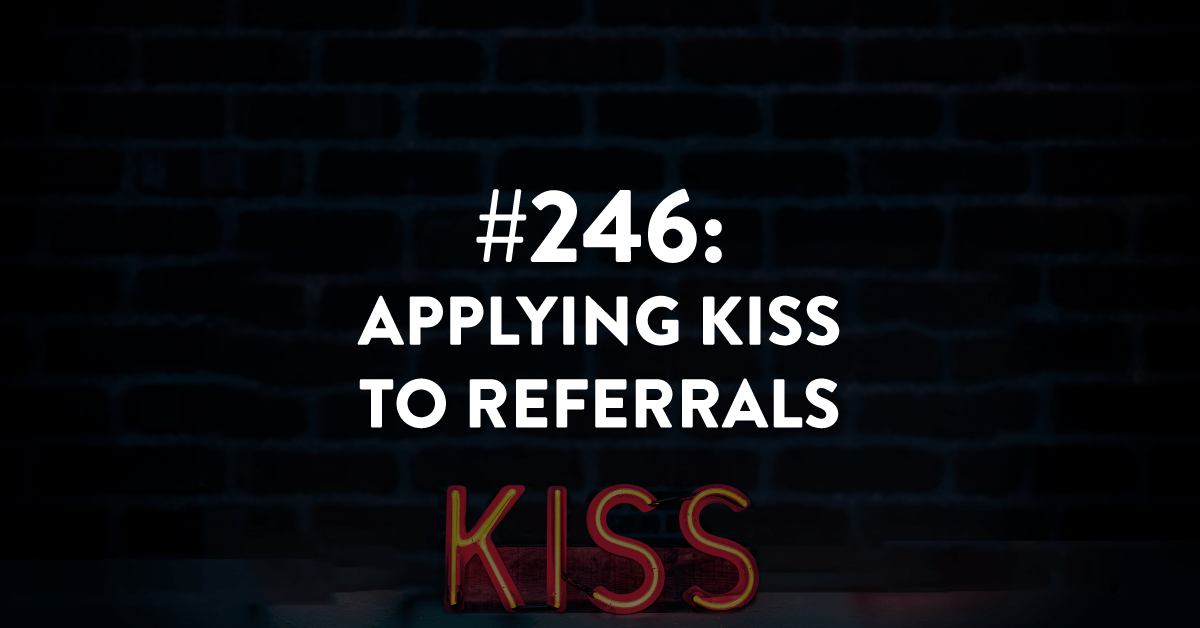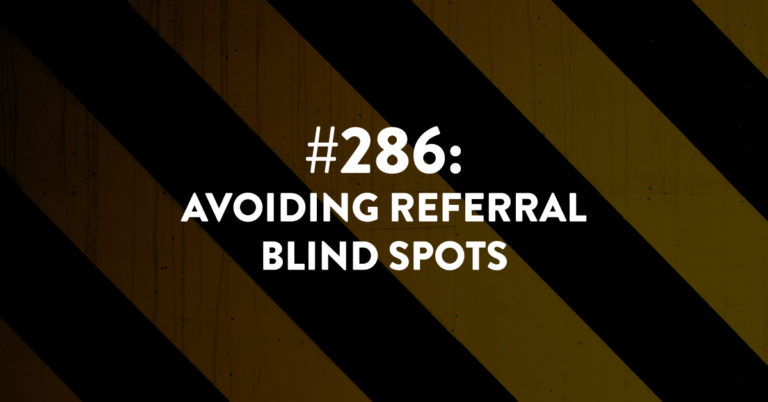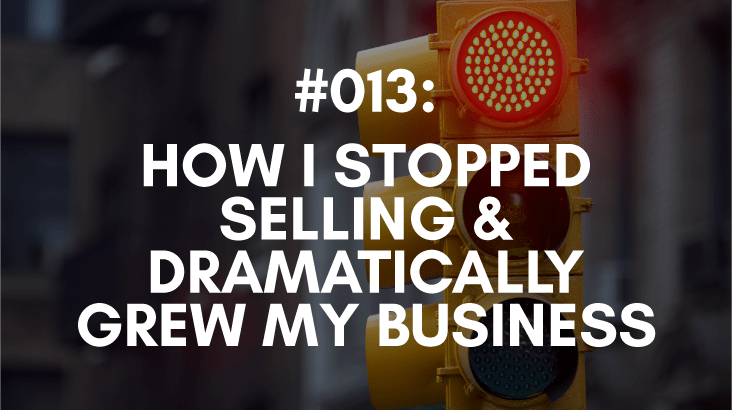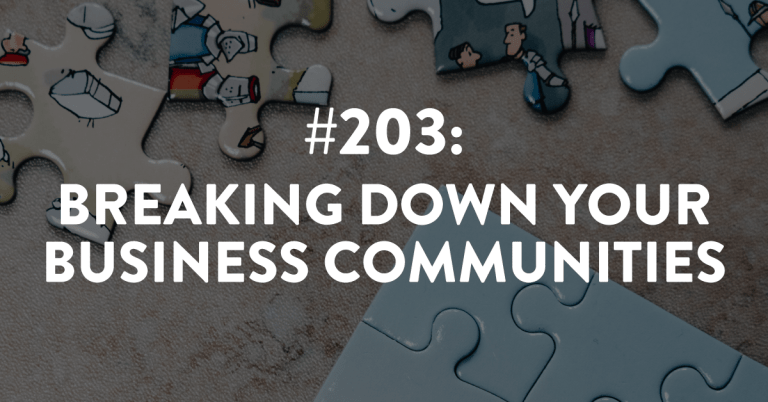Ep #246: Applying KISS to Referrals
Have you ever heard the saying, “Complexity is the enemy of growth”? When it comes to building a referral-based business, this couldn’t be more true. That’s why, in this episode, we’re going to talk about applying the KISS method to your referral strategies to keep things simple.
Now, I know what you’re thinking: How can I keep it simple when there are so many referral strategies out there? The key is to focus on what’s working and identify your biggest frustration or gap with receiving referrals.
We’ll dive into the importance of tracking referrals and how it can simplify the referral process. I’ll give you practical tips on how to track referrals, including identifying where new prospects came from. Listen in to gather the data you need to take the next step forward and build a successful referral-based business!
Links Mentioned During the Episode:
Want to learn how to double, triple or quadruple your referrals in one year??? Then join me on March 6th for a live private training. This training is specifically for those who are also interested in the coaching program, Building a Referable Business (BRB). Learn more about the private training and BRB now. You’ll need to complete the application to attend the training.
Next Episode:
Next episode is #247, and I’ll dig into whether affiliates and referrals can coexist.
Download The Full Episode Transcript
Read the Transcript Below:
Stacey Brown Randall: Complexity is the enemy of growth. So, when it comes to referrals, I want you to aim to apply the KISS philosophy.
Hey there, and welcome to episode 246 of the Roadmap to Referrals Podcast, a show about helping you build a referable business. I’m your host, Stacey Brown Randall.
I know you’ve heard this before, complexity is the enemy of growth. You’ve heard that, right? The more complicated, the more complex we make processes, procedures, the opportunity to work with you in our business — it actually stunts our growth. Because we’re so busy keeping up with all the processes and procedures that we’re not actually growing with ease.
And so, the more we make things complex and complicated and the 15 points, when maybe you could do that … instead of 15 steps, maybe you could get away with doing that in six steps, slows down everything, but in particular, it slows down our growth.
What we need is to apply the KISS philosophy (keep it simple, stupid). So, I’m going to be honest with you, that’s really not the nicest thing. I just feel like I’m calling everybody stupid and myself stupid when we say we got to apply the KISS strategy, the KISS philosophy of keep it simple, stupid.
So, we’re going to change that for the purpose of this episode. And I think maybe it should be keep it simple, simple — like double simples. Not as in you’re simple or I’m simple. Keep it simple, simple. That’s what we want to do. Anyway, let’s get back to the point of this episode.
Now, I’m about to sound like I’m going to contradict myself, but I want you to stay with me because I’m going to come back around to this concept of KISS. When people ask me about referrals and the different strategies or different ways or different things that they can do to generate referrals, I always tell them that I teach 18 different referral strategies as of right now.
“Whoa,” as you can imagine, you may have just said it yourself, is the typical response. First of all, let’s start by stating what I would hope would be obvious but may not be, so let’s start there. You don’t need them all. You do not need all 18 strategies that I teach.
Even when my members of my coaching program are going through, the BRB members are going through their time with me inside BRB (the coaching program), they won’t go through all 18 strategies. They can, they have access to them, but they won’t need to.
So, whereas it sounds like, whoa, 18 sounds like a lot, that sounds like a layer of complexity, it’s actually not. So, if your response is the same, like, “Whoa, there’s 18 strategies I need to know?” Well, you’re not ever going to apply all 18 strategies on any given day or any given week, or even any given month. So, don’t worry about that because here’s the thing, you don’t need them all.
And to decide which ones you do need depends really on where you’re starting from, what your ultimate goals are with referrals, and the gaps you have currently that we need to close.
Some of what I teach, those strategies, they’re foundational and most business owners will need a few of them. There’s actually three foundational strategies that we teach. Most need one or two, some need all three.
Other strategies are situational strategies, meaning you need to know what to say or do when a situation arises. So, when a situation arises, you need to say, “Oh, wait, I recognize this as word-of-mouth buzz. I’m going to apply the flip scripts within saving lost referrals to be able to flip this into a referral to know what to say in the moment because the situation calls for it.”
And then a few other strategies are only if your business has shifted and you need a next level strategy. And for some folks, they never will. So, 18 strategies, let’s be honest, how do we keep this simple?
Here’s two ways I want you to consider keeping your referral focus and keeping your referral strategies and the idea that you have of what referrals will look like in your business as simple as possible.
Number one, I need you to get clear on what you’re working with when it comes to referrals. I need you to get clear with what are you working with here? What is working in your business with referrals? What’s happening, or what’s not happening?
So, what’s working with referrals and what is not working? And so, the truth is there is always some common responses, and I’ll get back to those in just a minute.
But first, I want to talk to you about the second thing I’d like for you to do to keep it simple. So, the first thing is I want you to get clear on what’s working with referrals, with your referral reality, your referral generation right now in your business and what’s not working.
And then the second thing I want you to do is I want you to identify your biggest gap or frustration with receiving referrals, because we all have them. There’s always something that we just wish we could fix or solve that would make life easier when it came to referrals.
So, once you’re clear on what’s working and what’s not working and you’ve identified your biggest gap or frustration with receiving referrals, then let’s talk about the simplest place to start.
Hey there, pardon the interruption, real quick. Want to learn how to double, triple or quadruple your referrals in one year? Then join me on March 6th for a live private training. This training is specifically for those who are also interested in the coaching program, building a referral business (BRB).
Learn more about this special training and BRB at staceybrownrandall.com/referable. You will need to complete the BRB application before you can attend the training. And of course, this is a live training that I’ll be giving for you, but if you don’t think you can make it to the live one, don’t worry, if you register by completing your BRB application and you are accepted, then you’ll also get the recording.
So, the simplest place to start — so once we understand what’s working, what’s not working and then we’ve identified what our biggest gaps are, the frustrations we have with the referrals, the simplest place to start is to actually start tracking what’s happening with referrals in your business right now.
Simple tracking is the key, lose the complexity. So, when you think about what you’re going to track, what does that ultimately look like for you? It’s important for you to track the prospects that show up to have the potential to do business with you.
When you are tracking that prospect that you’ve just received, where will you track how they’ve heard about you? That’s the big key piece, I want you to put into place, if you don’t have it already.
How did they first learn about you? Where did they hear about you? Maybe it’s a question that a receptionist ask when they call in, maybe it’s a question on an intake form that you send over email or off of your website. Maybe it is a line that says, “Hey, how did you hear about us?”
So, for those folks who actually apply for my coaching program (BRB), the very last question on the application is how did you hear about Stacey?
If you’re signing up to do a referral audit with me, which is like a 30-minute call to talk about some easy ways you can solve some of your referral problems that you have in your business and then also to discuss if we are a good fit for working together through my coaching program, BRB, there’s a question on there that says, “Hey, how did you learn about Stacey?”
You should always be asking that question so that you can always be tracking the results. And when a client rolls into my world and I didn’t capture that information when they were a prospect and now, they’re a client, I’ll always circle back around and try to find out, “Hey, do you by chance, remember how you heard about me? Or how did you come to know me?”
So, the easiest place, the simplest place to start when you want to know what’s going on with referrals, what’s happening in your business right now is to do some simple tracking. So, track those prospects you receive but you need to understand ultimately what you’re tracking. What are you tracking? And then where are you keeping that information?
And of course, if you are tracking where they heard about you, and it’s a referral source, you need to make sure you’re tracking the referral source’s name. But start small and keep it simple. It’s really, really important.
So, when people talk to me about the things that aren’t working with their referrals, usually, what I hear … some common responses that I hear when people are — here’s all the things not working with referrals, rarely do I actually hear, “Here’s what’s working.”
Most of the time I hear, “Well, here’s what’s not working,” it’s because they don’t actually know what’s working, they don’t know the data. They have a sense, they have some recency bias, they have some opinions, but they’re not a hundred percent sure what is really working, and that is stressing them out.
That is causing them to assume that nothing is working when it comes to referrals. And a lot of that comes down because you don’t know. You need to be able to answer the questions, how many referrals do you average in a year? How many active referral sources do you currently have? Those are things you need to know. And if you don’t know them, it’s because you’re probably not tracking them.
And so, you could start today, right now listening to this episode. You can make sure that when a prospect shows up to do business with you, you’re also tracking how they learned about you, and then you’re capturing that someplace to keep up with it.
I don’t care if it’s a piece of paper, if it’s an Excel spreadsheet, if it’s a Google spreadsheet, a doc, it doesn’t matter to me. If it’s in a database, a CRM, a cheap free one, or a fancy one, it doesn’t matter, you need to track it.
Because tracking this will also start to reveal to you maybe there are some things that are working with referrals in your business. But tracking is always the simplest place to start. If we’re keeping it simple, simple, let’s start simply by tracking what’s happening.
We do the same thing inside BRB, the coaching program. There are 18 strategies, as I mentioned earlier, and it’s actually the only place where you can get access to all 18 is to be within BRB. But we start with tracking, we allow the tracking, the data to show us how to identify the very first strategy.
I’m going to have this new BRB member learn and then implement. The data based on their tracking is going to tell me what I need to know. And of course, I don’t expect everybody to have this information, we actually take you through a pre-work process when you join BRB that actually sends you a video and the template to download, so you can do this tracking the way that we do it.
But the data that comes out of that is going to tell us, here’s where we’re going first. And then of course, we co-create that, the new member and I on an onboarding call, so we make sure that we’re — I’m thinking they should start, where they ultimately want to start as well.
Right now, I’m going to dive into those 18 strategies. If you’ve never hear me talk about this before, I’ll dive into those 18 strategies in an upcoming episode when I talk about understanding the referral ecosystem.
But remember, right now, where you need to keep your focus is on what is simple. And what is simple is tracking, it gives you the information, the data that you need to know how to take the next step forward.
So, when it comes to referrals and you know pretty much anything in life and business, you need to KISS, keep it simple, simple.
Anything you’re looking for on this episode can be found on the show notes page at staceybrownrandall.com/246.
And coming up next week is episode 247. Ooh and I’m digging into what could be for some, but probably not for all a controversial topic. What? Who? Me? Of course, I never shy away. I’m going to dig into, if affiliates and referrals can coexist.
Until then, take control of your referrals and build a referable business. Bye for now.







